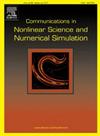时间分数正弦-戈登方程的校正 L1 方案的时点误差分析
IF 3.4
2区 数学
Q1 MATHEMATICS, APPLIED
Communications in Nonlinear Science and Numerical Simulation
Pub Date : 2024-09-26
DOI:10.1016/j.cnsns.2024.108370
引用次数: 0
摘要
在这项研究中,我们考虑了具有诺伊曼边界条件的时间分数正弦-戈登方程,其解在初始时间表现出典型的弱奇点。通过引入一个中间变量,原问题可以等价地写成一个低阶耦合系统。利用时间上的非均匀校正 L1 方案和空间上的有限差分方案,为耦合系统构建了一个完全离散的方案。此外,还严格确定了所提方案的稳定性。同时,建立了尖锐的时点误差分析。特别是,推导出的收敛结果意味着,在任意 1<α<2 的情况下,只需取分级参数 r=1,远离初始时间的误差就能达到 2-α/2 的最佳收敛率。最后,提供的数值结果验证了所提出的方案在时间和空间方向上都达到了最佳收敛率。本文章由计算机程序翻译,如有差异,请以英文原文为准。
Pointwise-in-time error analysis of the corrected L1 scheme for a time-fractional sine-Gordon equation
In this work, the time-fractional sine-Gordon equation with Neumann boundary conditions is considered, where the solutions exhibit typical weak singularities at initial time. By introducing an intermediate variable, the original problem can be equivalently written as a low-order coupled system. Utilizing the nonuniform corrected L1 scheme in time and the finite difference scheme in space, a fully discrete scheme is constructed for the coupled system. Furthermore, the stability of the proposed scheme is rigorously established. Meanwhile, a sharp pointwise-in-time error analysis is developed. In particular, the deriving convergent result implies that the error away from the initial time reaches the optimal convergence rate of by merely taking the grading parameter for any . Finally, numerical results are provided to verify that the proposed scheme achieves optimal convergence rates in both temporal and spatial directions.
求助全文
通过发布文献求助,成功后即可免费获取论文全文。
去求助
来源期刊

Communications in Nonlinear Science and Numerical Simulation
MATHEMATICS, APPLIED-MATHEMATICS, INTERDISCIPLINARY APPLICATIONS
CiteScore
6.80
自引率
7.70%
发文量
378
审稿时长
78 days
期刊介绍:
The journal publishes original research findings on experimental observation, mathematical modeling, theoretical analysis and numerical simulation, for more accurate description, better prediction or novel application, of nonlinear phenomena in science and engineering. It offers a venue for researchers to make rapid exchange of ideas and techniques in nonlinear science and complexity.
The submission of manuscripts with cross-disciplinary approaches in nonlinear science and complexity is particularly encouraged.
Topics of interest:
Nonlinear differential or delay equations, Lie group analysis and asymptotic methods, Discontinuous systems, Fractals, Fractional calculus and dynamics, Nonlinear effects in quantum mechanics, Nonlinear stochastic processes, Experimental nonlinear science, Time-series and signal analysis, Computational methods and simulations in nonlinear science and engineering, Control of dynamical systems, Synchronization, Lyapunov analysis, High-dimensional chaos and turbulence, Chaos in Hamiltonian systems, Integrable systems and solitons, Collective behavior in many-body systems, Biological physics and networks, Nonlinear mechanical systems, Complex systems and complexity.
No length limitation for contributions is set, but only concisely written manuscripts are published. Brief papers are published on the basis of Rapid Communications. Discussions of previously published papers are welcome.
 求助内容:
求助内容: 应助结果提醒方式:
应助结果提醒方式:


